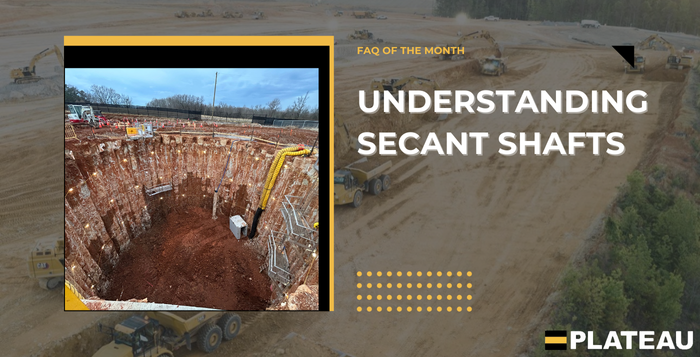Plateau Excavation

Secant shafts, also known as secant pile shafts, are an innovative construction technique used to provide robust lateral support for deep excavations and underground structures. This method has gained popularity due to its versatility and effectiveness in challenging geotechnical conditions.
What is a Secant Shaft?
A secant shaft is a type of deep vertical excavation supported by intersecting secant piles. These piles form a continuous wall that retains soil and water, creating a secure structure for excavation in challenging environments.
Construction Process
The construction of a secant shaft involves several key steps:
- Site Preparation: The construction site is prepared by setting up guide walls or drilling templates to ensure precise alignment and spacing of the piles.
- Drilling Primary Piles: The primary piles are drilled first. These are typically unreinforced concrete piles that provide the initial structural support.
- Drilling Secondary Piles: After the primary piles have set, secondary piles are drilled. These piles overlap with the primary piles, cutting into the previously placed concrete to form a continuous wall.
- Reinforcement and Concrete Pouring: Depending on the design requirements, reinforcement may be added to the secondary piles before pouring concrete. This step ensures the structural integrity of the shaft.
- Excavation and Support: Once the secant pile wall is complete, excavation can proceed within the enclosed area. Additional support methods, such as bracing or tiebacks, may be used to stabilize the excavation
Advantages of Secant Shafts
Secant shafts offer several advantages over traditional excavation support methods:
- Versatility: Secant shafts can be constructed in a variety of soil and rock conditions, including saturated soils, hard rock, and even through man-made obstructions.
- Watertight Barrier: The overlapping piles create a watertight barrier, making secant shafts ideal for projects with high groundwater levels.
- Structural Integrity: The continuous wall formed by the overlapping piles provides excellent structural support, reducing the risk of soil collapse during excavation.
- Depth Capability: Modern drilling equipment and techniques allow secant shafts to be constructed to greater depths than previously possible, making them suitable for deep excavation projects
Applications of Secant Shafts
Secant shafts are used in a variety of construction projects, including:
- Tunneling: Secant shafts provide access and support for tunnel construction, particularly in urban areas where space is limited.
- Basements and Underground Structures: They are commonly used for constructing basements, underground parking garages, and other subterranean structures.
- Retaining Walls: Secant shafts can serve as retaining walls for deep excavations, preventing soil movement and groundwater infiltration.

How We Used A Secant Shaft

 The type of application that we used the secant shaft for is a pump station. This particular secant shaft is 45 ft deep.
The type of application that we used the secant shaft for is a pump station. This particular secant shaft is 45 ft deep.
Conclusion
Secant shafts represent a significant advancement in construction technology, offering a reliable and versatile solution for deep excavation support. Their ability to create watertight, structurally sound barriers in challenging geotechnical conditions makes them an invaluable tool for modern construction, mission critical projects. As drilling equipment and techniques continue to improve, the applications and capabilities of secant shafts are likely to expand, paving the way for even more ambitious construction endeavors.
#AlwaysMovingForward

